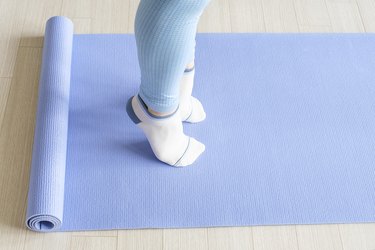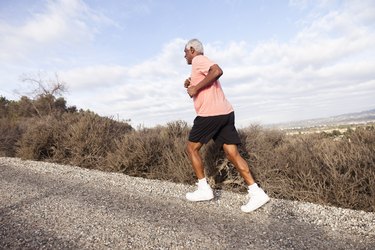
Leg pain is often a symptom of injury or overworked muscles, but it can also be related to poor circulation or disorders of the spine. If your leg pain occurs or worsens while climbing stairs, this is an important clue for your doctor to know. So if the cause isn't clearly related to an injury or overuse, see your doctor for an evaluation of your symptoms.
Muscle and Tendon Problems
Video of the Day
Most leg pain is a consequence of injury or overuse, caused by sports, exercise or even everyday activities. Leg pain can stem from a sprain, which is a stretched or torn ligament, or from strains — or injuries to the muscles or tendons. Musculoskeletal pain can occur suddenly or can build up and get worse over time.
Video of the Day
Although most sprains, strains or inflammation affecting the soft tissues in the calf, thigh or knee can cause leg pain whether active or at rest, these injuries can also get worse with weight-bearing activities such as stair climbing or walking up hills.
Nerve Leg Pain
Sometimes the source of leg pain is with your nerves. One such example is piriformis syndrome, which occurs when the piriformis muscle that runs from the lower spine to the top of the thigh bone presses against the sciatic nerve, which runs down the back of each leg. This syndrome can cause pain in the buttocks, thigh, calf and foot, and the pain can be more intense when climbing stairs.
Other back problems can also lead to leg pain, such as a herniated disk, which can irritate the nerves that lead to the legs and feet, or spinal stenosis, a narrowing of the spinal column that places extra pressure on the nerves of the spine — including the ones that lead to the legs and feet. However, the pain from these problems may be ongoing and not specific to walking inclines or climbing stairs.
Peripheral Vascular Disease
Peripheral artery disease (PAD) occurs when the arteries that supply blood from your heart to your legs and feet become partially or completely blocked. PAD is usually caused by hardening of the arteries, or atherosclerosis, and a classic symptom is cramping or pain in the affected leg — particularly when walking or climbing stairs.
Although this pain usually goes away with rest, severe PAD may cause constant pain, numbness, and cold, pale tissue in the affected leg. Another serious cause of pain in the leg, which can worsen with climbing stairs, is deep vein thrombosis (DVT), a blood clot in the deep tissues of the leg.
See a Doctor
If you have pain in your legs that is clearly related to a sports injury or recent overuse of leg muscles, home care measures such as RICE (rest, ice, compression and elevation) can improve your symptoms.
There are many different causes of leg pain — some very serious — and it's important that your doctor evaluate the cause of any ongoing or severe pain. If your pain doesn't improve or if you have leg pain that occurs whenever you walk or climb stairs, let your doctor know.
Warning
See your doctor as soon as possible if you have any signs of PAD, including calf pain when walking or climbing the stairs, and seek immediate medical attention if you have severe leg pain or if your leg pain is accompanied by tissue redness, swelling or fever.
- Merck Manual: Peripheral Arterial Disease
- FamilyDoctor.org: American Academy of Family Physicians: Piriformis Syndrome
- American Academy of Orthopaedic Surgeons: Lumbar Spinal Stenosis
- American Academy of Orthopaedic Surgeons: Herniated Disk in the Lower Back
- Merck Manual: Osteoarthritis
- American Academy of Orthopaedic Surgeons: Sprains, Strains and Other Soft-Tissue Injuries
Is this an emergency? If you are experiencing serious medical symptoms, please see the National Library of Medicine’s list of signs you need emergency medical attention or call 911.


